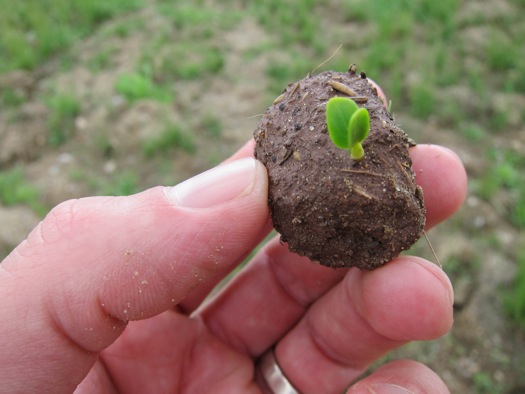On Sunday afternoon, when the rain finally stopped coming down, the kids and I walked over to Water Street to do some weeding, and we were pleasantly surprised to find that a good number of our nearly 3,000 seed bombs had begun to sprout…
I have no idea how long it will take before we have plants of any appreciable size, but at least the process is underway, and that makes me incredibly happy.
While we’re on the subject of this small parcel of land that we’ve been working on together in downtown Ypsilanti, I wanted to share a clip from an article that ran in the New York Times this weekend.
…Cities need public spaces like plazas. For years they have mostly been planned from the top down. In New York, zoning laws have carved many of these spaces from commercial developments, which have been given bonuses to include them. Mayor Bloomberg is pushing a new proposal to rezone east Midtown, near Grand Central, that is a variation on this same old trickle-down theme.
But fresh thinking has focused on cheap, quick, temporary and D.I.Y.-style approaches to creating public space — among these, curbside “parklets” in San Francisco and a communal farm on what had been a derelict parcel in the middle of Phoenix. “Small steps, big changes,” as Janette Sadik-Khan, the New York City Department of Transportation commissioner, described the logic of plazas like that at New Lots.
And guess what? A beer garden made out of freight containers on an empty plot turns out to be a lot more popular and better for a city than a sad corporate atrium with a few cafe tables and a long list of don’ts on the wall.
As more and more educated Americans, especially younger ones, are looking to move downtown, seeking alternatives to suburbs and cars, they’re reframing the demand for public space. They want elbow room and creative sites, cooked up by the community or, like the plaza program, developed from a democratic mix of top-down and bottom-up governance…
I hope that, just maybe, that goes a little way toward answering the question: “Why do we need a commons when we have a park right across Michigan Avenue?”
We, as human beings, need to create. We need to feel as though we’re part of something bigger than ourselves. We need to see new life. We need to plant seeds together and watch them grow. That’s what community is all about. And that’s what, in my opinion, will ultimately make Ypsilanti a success.














7 Comments
As we’ve owned the property for 14 years, and nothing has happened on it, I can’t imagine that anyone in the city could possibly have a negative thing to say about this project. I can see how Giving up a little control could be scarey, but what do we really have to lose by encouraging local people who want to create something?
Totally beautiful photos. I’m glad to see that thinks are working.
Progress.
Did anyone take you up on the idea of doing a time-lapse video of the site as it transforms?
The New York Times article is great. There’s so little to be enthusiastic about these days. There are so few beautiful little surprises. Democratization of space is so vitally important, and I’m encouraged that people are beginning to recognize it. For a while it seemed like people were OK trading their public squares for malls.
Fabulous little buds of green life! Congrats, kudos, and THANKS!!!!
I don’t think they’re right about it being the first one in the nation, but this is still an interesting article on Seattle’s food forest.
One Trackback
[…] Finding historical precedent for a commons on Water Street The day the official sign went up The sprouts started coming up The prairie first came to […]